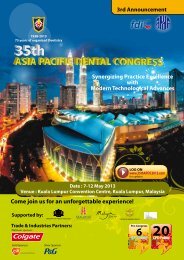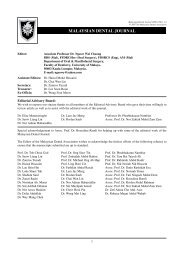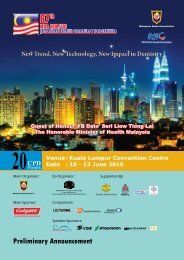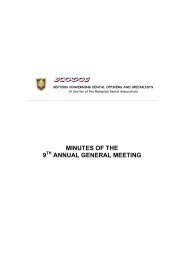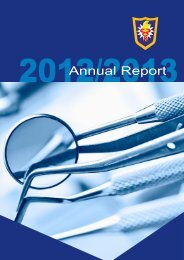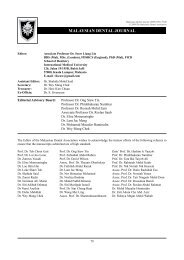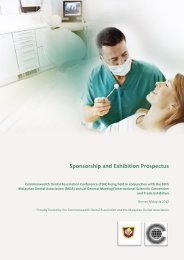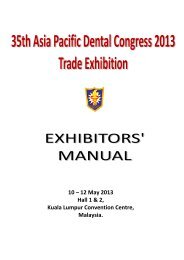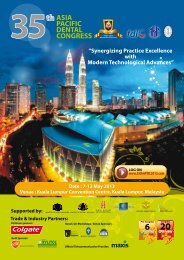Surgical Reconstruction Of The Lost Interdental Papilla Using RollTechnique - A Case ReportAuthors:Rizwan M SanadiMDS, Reader, Dept of Periodontics, Yerala Medical Trust & Research Centre’s <strong>Dental</strong> College & Hospital, Kharghar,Navi Mumbai- 410210 Maharashtra, India.Asha A PrabhuMDS, Reader, Dept of Periodontics, Yerala Medical Trust & Research Centre’s <strong>Dental</strong> College & Hospital, Kharghar,Navi Mumbai- 410210 Maharashtra, India.Kavita G PolMDS, Lecturer, Dept of Periodontics, Yerala Medical Trust & Research Centre’s <strong>Dental</strong> College & Hospital, Kharghar,Navi Mumbai- 410210 Maharashtra, India.ABSTRACTThe open gingival embrasure, also called the “black triangle,” is a visible triangular space caused by the lack ofinterdental gingival papilla filling this area resulting in esthetic impairments, phonetic problems and food impaction.The central and lateral incisors are the most dominant anterior teeth in the maxillary arch because they can be fullyvisible in patients with a broad smile. In such patients the open gingival embrasure between the maxillary centraland lateral incisors interferes with the esthetics of their smile. Several surgical and non-surgical techniques havebeen proposed to treat the loss of interdental papilla and manage the interproximal space. The present case reportdescribes surgical reconstruction of the interdental papilla using roll technique.Key Words: Interdental papilla loss, esthetic impairment, phonetics, black triangleINTRODUCTIONThe absence or loss of interdental papilla is ofmajor concern in smile designing. The loss of interdentalpapilla may create esthetic impairments, phoneticproblems and food impaction. 1 The interdental papillais formed by a dense connective tissue covered byoral epithelium. The contact relationships betweenthe teeth, width of the approximal tooth surfacesand course of the cemento-enamel junction (CEJ)determine the shape of the interdental papilla. Inthe anterior region, it is pyramidal in shape. In thepremolar/ molar regions, the buccal and lingual papillaare separated by a concavity known as the “col.” 2The presence or absence of the interdentalpapilla is correlated with the vertical distance betweenthe contact point and the crest of the bone. Whenthe tissue fills the embrasure completely, the papillais considered to be present. When the space is visibleapical to the contact point, the papilla is deemedmissing. When the vertical distance from the contactpoint to the crest of bone is 5mm or less, the papilla ispresent almost 100% of the time. When the distance is6mm or more, the papilla is usually missing. 2The interdental papilla can be lost as a resultof several distinct clinical situations like, naturallyoccurring diastemas, divergent roots, a triangularshaped clinical crown, periodontal disease or as aresult of periodontal surgical procedures. 3 The opengingival embrasure, also called the “black triangle,”is a visible triangular space caused by the lack ofinterdental gingival papilla filling this area. The centraland lateral incisors are the most dominant anteriorteeth in the maxillary arch because they can be fullyvisible 1 in patients with a broad smile. In such patientsthe open gingival embrasure between the maxillarycentral and lateral incisors interferes with the estheticsof their smile. 4Several surgical and non-surgical techniqueshave been proposed to treat the soft tissue deformitiesand manage the interproximal space. The nonsurgicalapproaches (orthodontic, prosthetic and restorativeprocedures) modify the interproximal space, therebyinducing modifications to the soft tissues. The surgicaltechniques aim to recontour, preserve or reconstructthe interdental papilla. 1Surgical techniques aimed at correcting thelost interdental papilla include: free epithelializedgingival grafts, repeated interproximal curettage, 4 or41<strong>Malaysian</strong> <strong>Dental</strong> Journal Jan-Jun 2011 Vol 32 No 1© 2011 The <strong>Malaysian</strong> <strong>Dental</strong> <strong>Association</strong>
Surgical Reconstruction Of The Lost Interdental Papilla Using Roll Technique - A Case Reportdisplacement of the interproximal palatal tissue in thebuccal direction. 5The present case report describes a case ofreconstruction of the interdental papilla using rolltechnique (involving displacement of the interproximalpalatal tissue in the buccal direction).CASE REPORTA 24 years old male patient reported to theDepartment of Periodontics with the chief complaint ofan unpleasant smile. On examination there was partialloss of the interdental papilla in the midline betweenthe maxillary central incisors (Fig. 3). The interdentalpapilla occupied one-third of the interproximalembrasure space. The soft tissues presented a healthyclinical aspect with minimal sulcus depth and theinitial therapy consisted of oral prophylaxis. Patientwas instructed on the significance and maintenanceof good oral hygiene. The surgical procedure wascarried out under an adequate antibiotic coverage[Doxycycline 100mg (twice on the first day and oncedaily for the next 5days)] and anti-inflammatorycoverage [Ibuprofen 400mg thrice daily for 4days}starting one day prior to the surgery. 2% Lignocainehydrochloride with 1:80,000 adrenalin was used as thelocal anaesthetic agent.Surgical ProcedureAfter adequate local anaesthesia was obtained,a William’s graduated periodontal probe was used tomeasure the distance between the alveolar bony crest(abc) to the desired height of the papilla reconstruction(pr). A partial thickness incision was made using aNo.15 blade mounted on a Bard Parker handle. Thisincision was made such that it started from the mesiofacialline angle of right central incisor, extended alongits mesial surface upto its mesio-palatal line angle.From here the incision was continued onto the palateextending upto a distance of twice abc-pr. The secondincision was started on the mesio-facial line angle ofthe adjacent left central incisor, extended in the samemanner along its mesial surface upto its mesio-palatalline angle. Then extending onto the palatal upto adistance of twice abc-pr. Then the two incisions wereconnected by a horizontal incision (Fig. 1). A partialthickness flap was then dissected using a periostealelevator and the flap was pushed with gentle pressurethrough the embrasure space onto the labial side (Fig.2, 4, 5). The unhealthy granulation tissue, if present,was curetted and the root surfaces of the adjacentteeth thoroughly planed. The elongated papilla wasthen folded upon itself to approximate the connectivetissue sides in a manner similar to the roll techniquefor ridge augmentation. The lateral aspects of thepapilla were contoured using a scissor to create thedesired pyramidal form. Then Ethicon suture material(3-0 black silk swaged onto the needle) was used tobind the laminated papilla together and suspend itbetween the two central incisors with a sling suturearound adjacent tooth (Fig. 6). The same procedurewas repeated on the left lateral incisior.Periodontal dressing was applied to the palatalaspect to act as a scaffold for the reconstructed papillaand on the labial aspect to position the papilla properlyand immobilise it (Fig. 7).Figure 1: Partial thickness incision made on palatalgingivaFigure 2: Cross-sectional view of roll techniqueprocedureFigure 3: Pre-operative view of the unesthetic openembrasure between central incisors<strong>Malaysian</strong> <strong>Dental</strong> Journal Jan-Jun 2011 Vol 32 No 142



